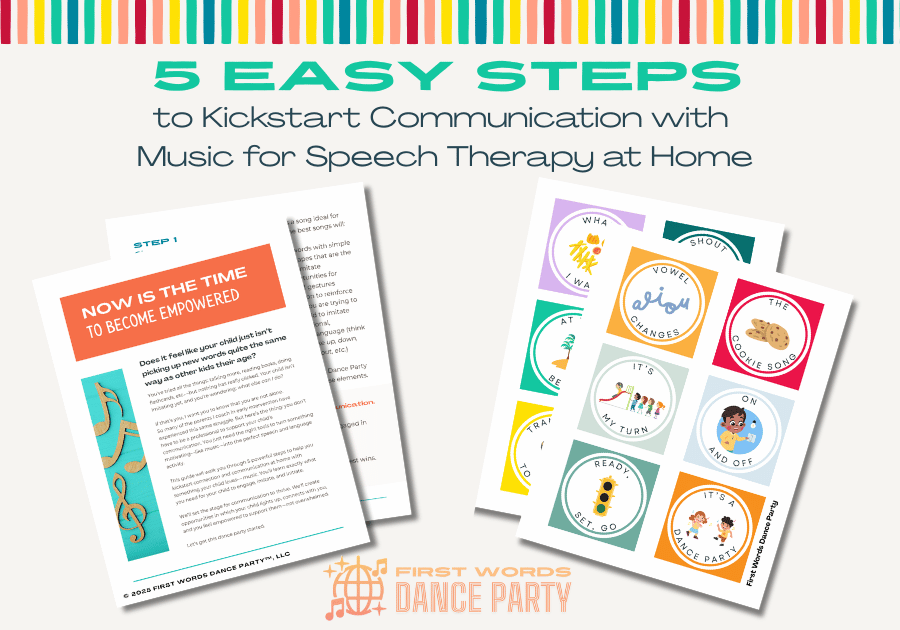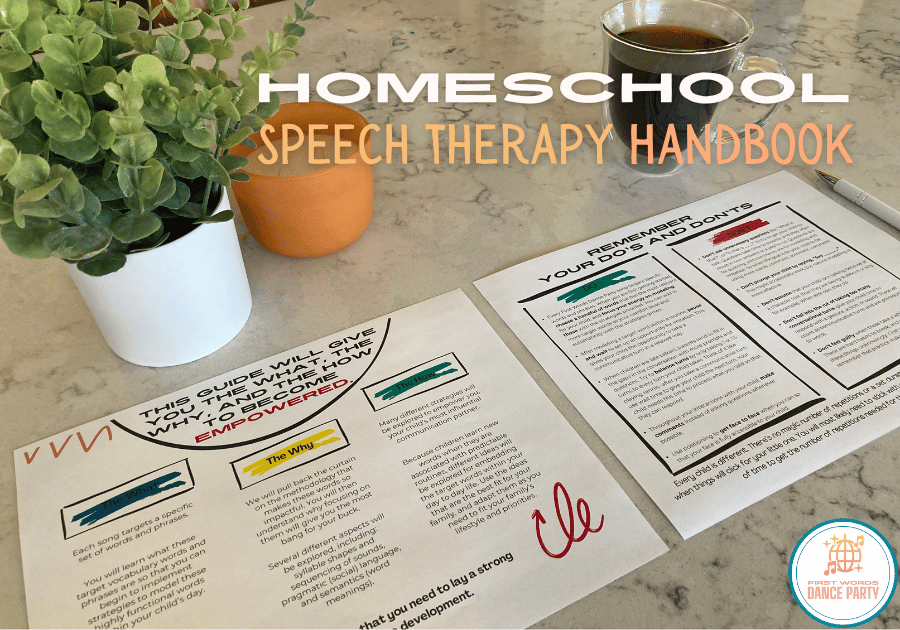Autism or speech delay? How to be sure when your wonderful child's not talking
- 1 comment
When your child isn’t talking as expected, the question often becomes: is it autism or speech delay?
You’ve tried talking more and reading more books—but your child still isn’t talking yet. Naturally, you’re starting to wonder whether it’s a speech delay or autism and looking for information that might tell you which is the case for your child.
In this article, we’re going to walk through speech delays and autism: what each one means, how they're alike and different, and how they sometimes overlap.
If your child isn’t using many words yet, you may be unsure of what to do and what not to do- and you’re not alone. Many parents I coach in early intervention feel stuck, frustrated, or overwhelmed when their child won’t imitate their words.
That’s why I started creating music for speech therapy that weaves in the strategies we use everyday in early intervention.
You can download a free guide to discover 5 easy, parent-friendly steps to use songs for speech therapy at home to spark connection and communication with your child. As a bonus, you’ll receive song boards with cards for every First Words Dance Party™ song, so your child can make choices and initiate.
And with that, let’s get to your questions.
What Is a Speech Delay?
A speech delay is when a child isn’t developing speech and language skills as quickly as expected for their age. This might look like a child who isn’t saying more than a few words by 18 months or using at least 50 words and combining words together by age 2.
A speech delay is also referred to as late language emergence (LLE). The American Speech-Language-Hearing Association defines late-language emergence as:
“A delay in language onset with no other diagnosed disabilities or developmental delays in other cognitive or motor domains. LLE is diagnosed when language development trajectories are below age expectations. Toddlers who exhibit LLE may also be referred to as ‘late talkers’ or ‘late language learners.’”
What causes speech delays?
The causes of speech delays in otherwise healthy, neurotypical children are not known. There are several variables that are linked with speech delays however, like family history, motor development, gender, and siblings.
Sometimes, a speech delay exists on its own and a child catches up by kindergarten with a little support and extra time. Other times, it’s part of a broader developmental picture, like a language disorder, motor planning difficulty, or neurodevelopmental difference.
Many children with speech delays close the gap between themselves and their peers by late preschool or kindergarten—especially with early support. Others may continue to need help with speech or language development as they grow, and that’s okay too.
Research from the American Speech-Language-Hearing Association (ASHA) emphasizes that early identification and family involvement can significantly improve long-term communication outcomes.
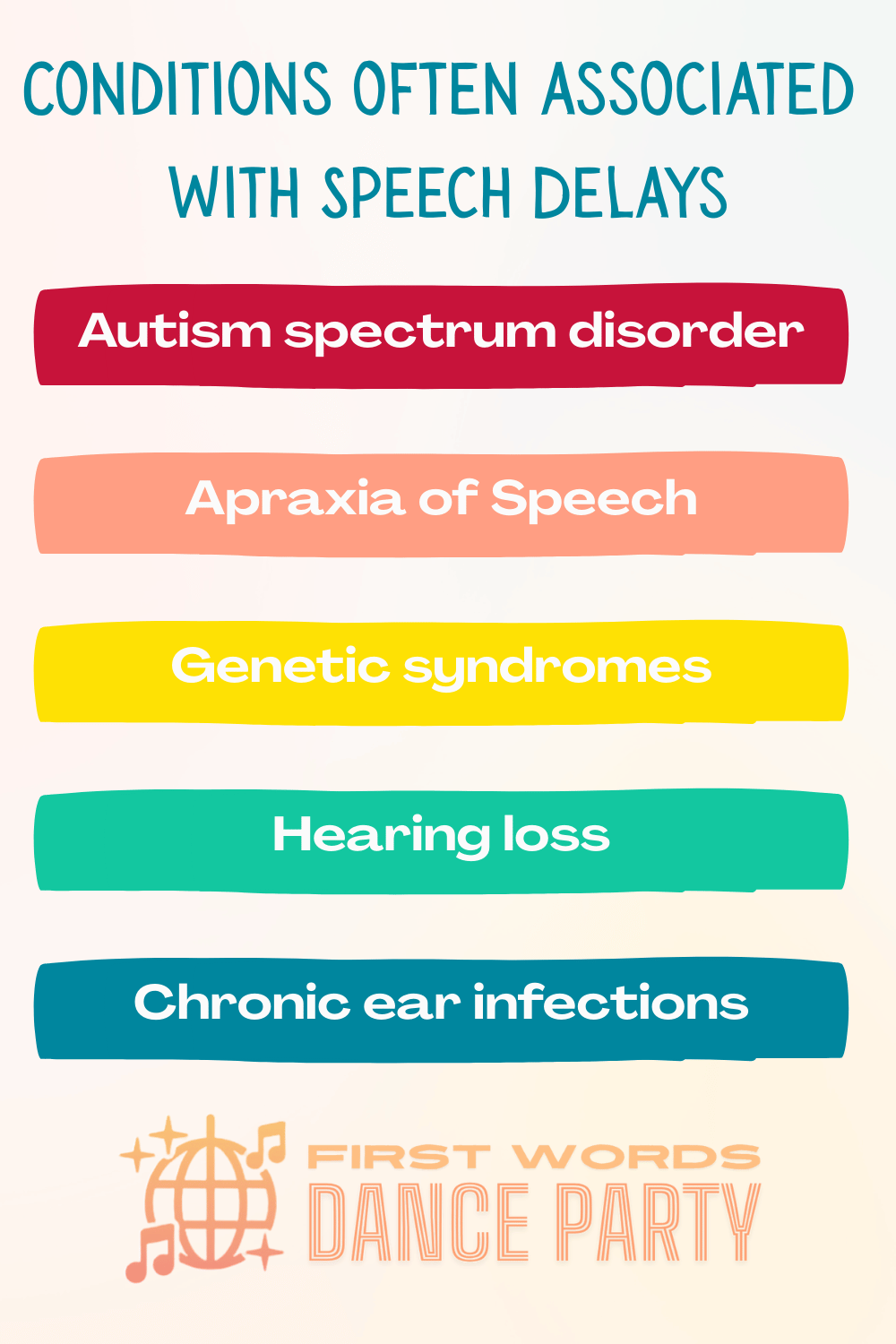
What conditions are known to hinder communication?
While a speech delay can occur on its own, there are several disorders and other diagnoses that are known to impact the development of speech and language. Some of the most common include:
Childhood Apraxia of Speech
Hearing loss
Chronic ear infections
Genetic syndromes (like Down syndrome or Fragile X syndrome)
Autism Spectrum Disorder
Each child is unique, and a speech delay doesn't automatically point to any one condition. But when a speech delay appears alongside other characteristics—like differences in play, social engagement, or sensory responses—it may be part of something broader, like autism.
Let’s explore what that looks like next.
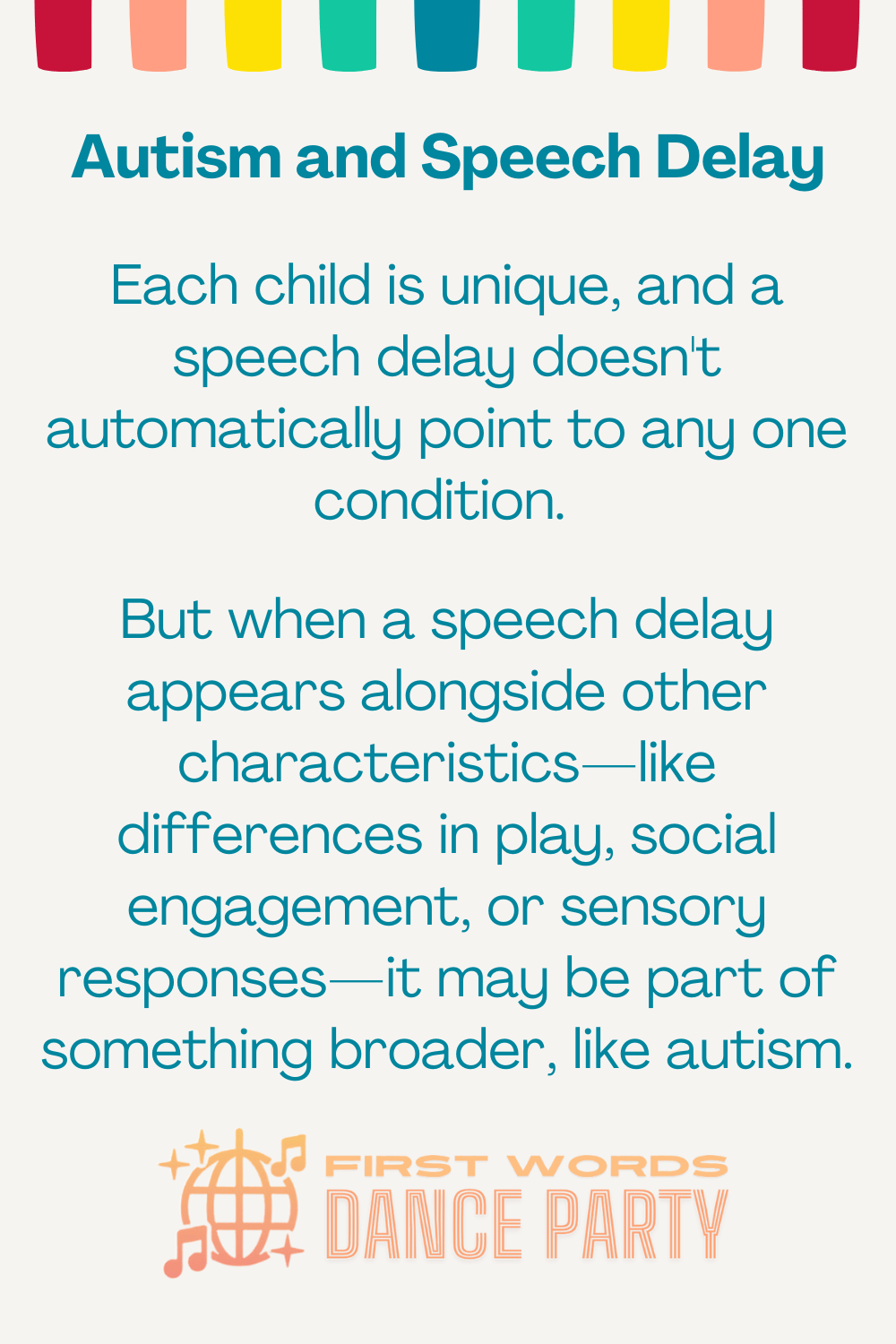
What Is Autism?
Autism spectrum disorder is a neurodevelopmental difference that affects how a child learns, communicates, and forms connections.
Autism is a spectrum, and no two individuals are the same. Dr. Stephen Shore once said,
“When you meet one person with autism, you've met one person with autism.”
While individuals on the autism spectrum do share certain core features, no two people with a diagnosis are exactly alike. Every autistic person has a unique set of strengths and varying levels of support needs.
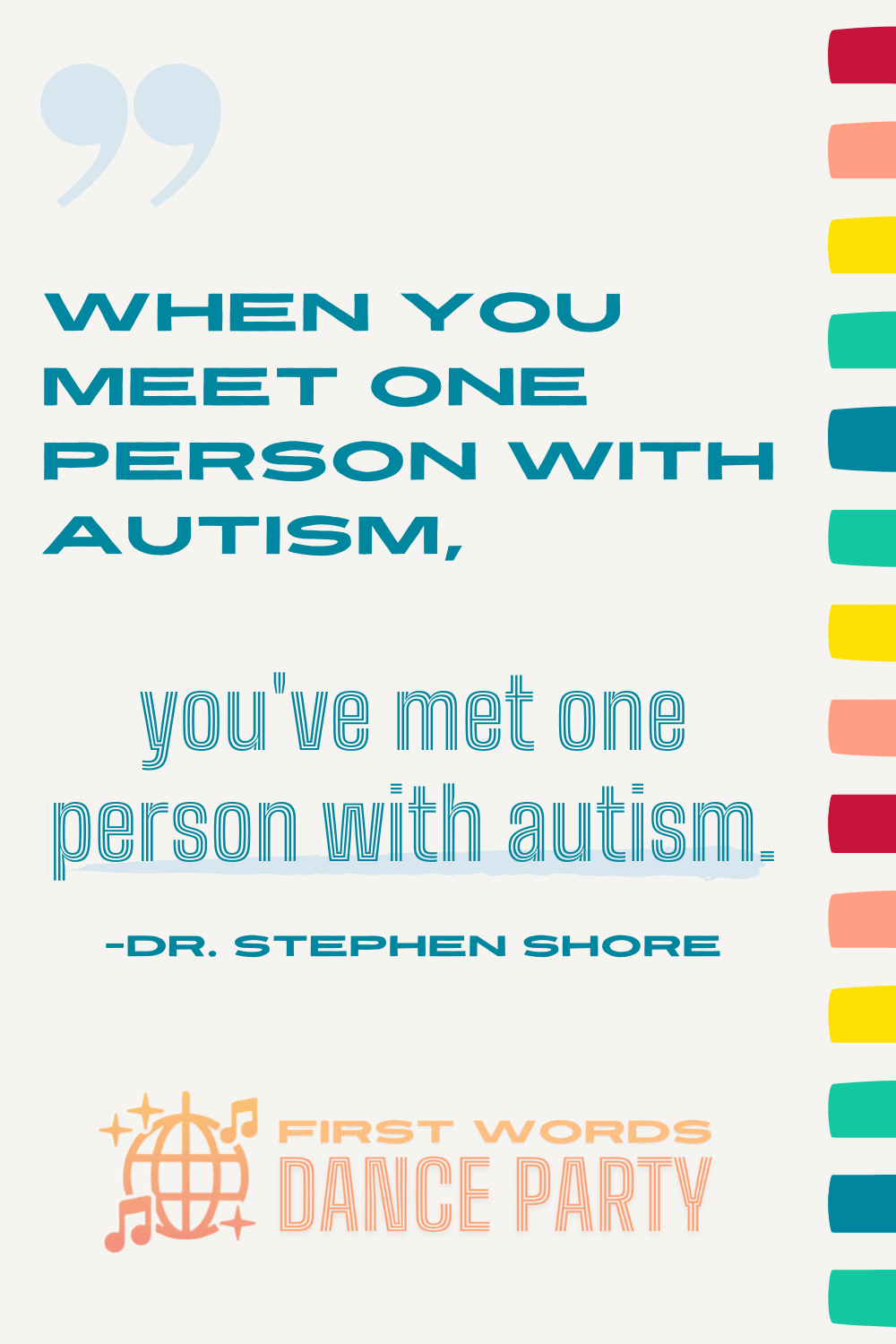
A note on identity-first language
In this blog, I use the terms “autistic” and “on the autism spectrum,” reflecting preferences shared by many in the adult autistic self-advocacy community. According to a 2015 study in the journal Autism, identity-first language is often preferred over person-first language (i.e., "person with autism"), because it recognizes autism as a core part of a person’s identity—not something to be separated from them.
What is the autism triad?
To receive a diagnosis of autism, a child must demonstrate challenges in three core areas:
1. Communication and language – including differences in how language is used to share ideas, ask for help, or respond in conversation. Many autistic children are late to talk and benefit tremendously from Augmentative and Alternative Communication (AAC), sign language, and visuals.
Many children on the autism are gestalt language processors who process language in whole chunks rather than by understanding language at the individual word level. If your child tends to easily repeat lines from shows or favorite songs, but has a harder time imitating people spontaneously, make sure to check out the three-part blog series including this article on gestalt language processing myths.
2. Social interaction – including differences in how they initiate or respond to social connection. This may include a preference for playing alone or limited back-and-forth interaction.
3. Restricted or repetitive behaviors – including things like strong interests in certain objects, shows, or topics, and a need for routines and predictability. This category also includes sensory differences, such as being very sensitive to nonpreferred foods, or seeking out lots of movement.
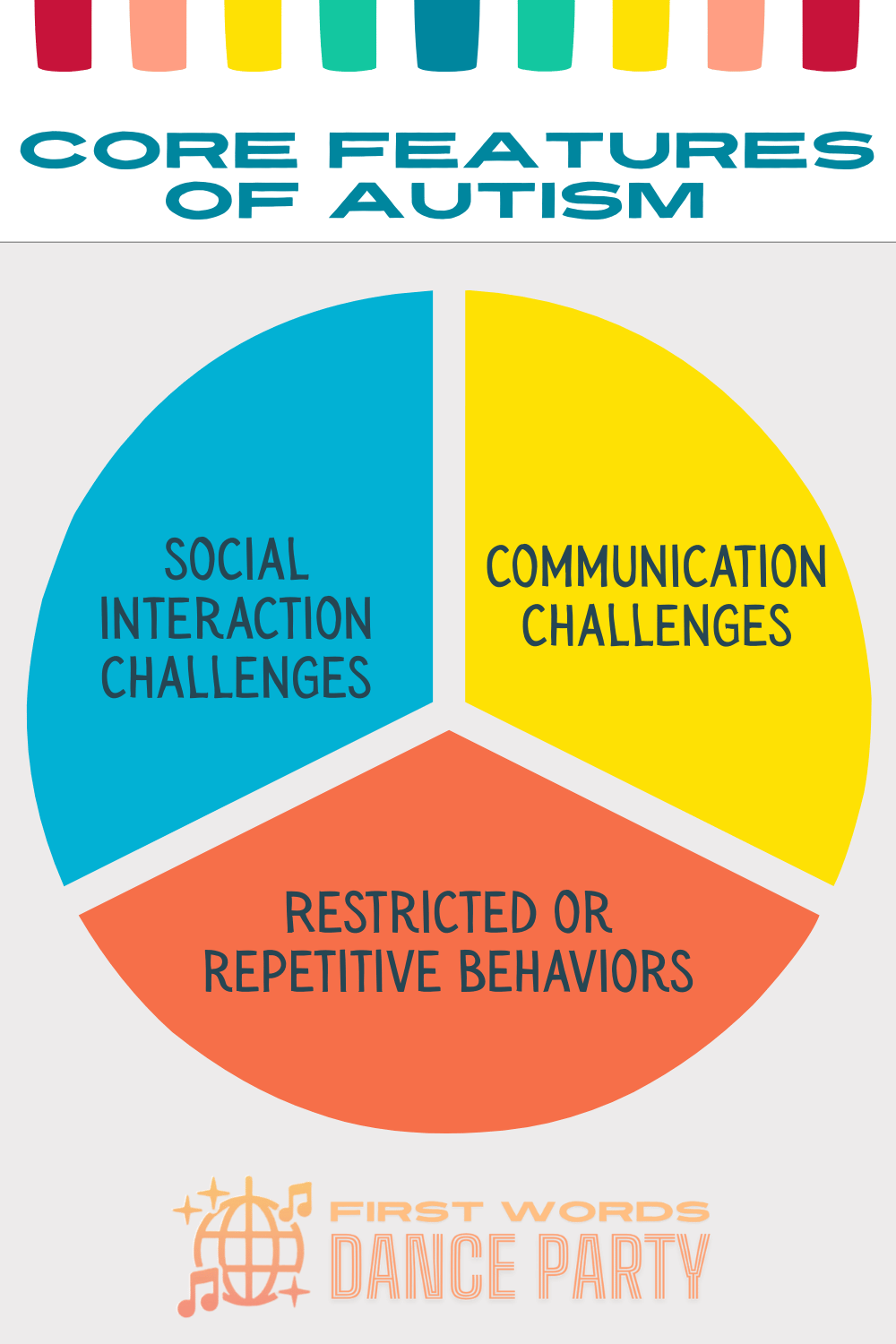
It is helpful to think of the core features as a learning style. With that learning style comes many wonderful and unique strengths as well as challenges- and those challenges are what contribute toward a child’s delayed language, or speech delay.
Autism speech delay: what does this look like in toddlers?
Every child is different, and when it comes to parenting a toddler, it can be hard to know what is and isn’t “normal” for social skills, language, behavior, and play when our children are so young.
So how do you know if your late-talking toddler is demonstrating characteristics of autism or is just a spunky, fun, unique kid?
We look for a constellation of characteristics.
Seeing the constellation
When a toddler or preschooler demonstrates several characteristics within those three core areas, then we start to see the “constellation”. We can see how the different challenges and strengths a child is demonstrating may actually be representative of the three core features within the autism triad.
I really like the constellation analogy. When you’re a parent of a toddler or preschooler, it can be incredibly hard to try to make sense of autism when your child is so young. The constellation analogy helps to illustrate how autism is really a pattern of characteristics.
Everyday examples of toddlers
Here are the most common real-life examples that I see every single day in my work with toddlers on the autism spectrum in their homes:
Not yet using a wide variety of gestures like pointing, waving, giving high fives, or nodding “yes”
Had a few words they used to say, but then stopped saying them
Hard to redirect/distract from strong interests in specific objects, like shoes, spoons, the alphabet/numbers, or sticks (just a few examples, but a child on the spectrum could be very enthusiastic about any object that brings them joy)
Not yet playing with a wide variety of different toys
Lining up toys or other objects, or play looks mostly like taking things out or a container and then putting them back. This often happens in place of flexible, pretend play.
Not yet responding to name or following simple directions like “Put your cup in the sink.”
Highly selective eater
Using echolalia (repeating lines from songs or shows), but has a much harder time imitating words used by other people within regular activities
Preferring to play alone when peers are present, or wandering away from a parent or peer when they try to join in
Slightly behind with gross motor skills, like walking up and down the stairs
Pulling a parent to something they need help with, like opening the fridge, or placing something in a parent’s hand they need help with, like opening a snack— without looking at the parent’s eyes to communicate
Struggling with transitions in a way that is more intense and frequent than typical for toddlers
Strong visual learning skills; notices small details like shadows and reflections
Loves items that spin, like fans and wheels
Cries and becomes anxious in new or unfamiliar places and around unfamiliar people
You might look at one or two of these things and think, “That’s just normal toddler behavior,”- and this is where the autism constellation really helps. If a child demonstrates just one or two of these things- yup, that can absolutely be normal toddler behavior.
It is when we see several different characteristics across the triad (communication, social, and restricted and repetitive behavior) that we see a pattern that starts to look like the constellation of autism.
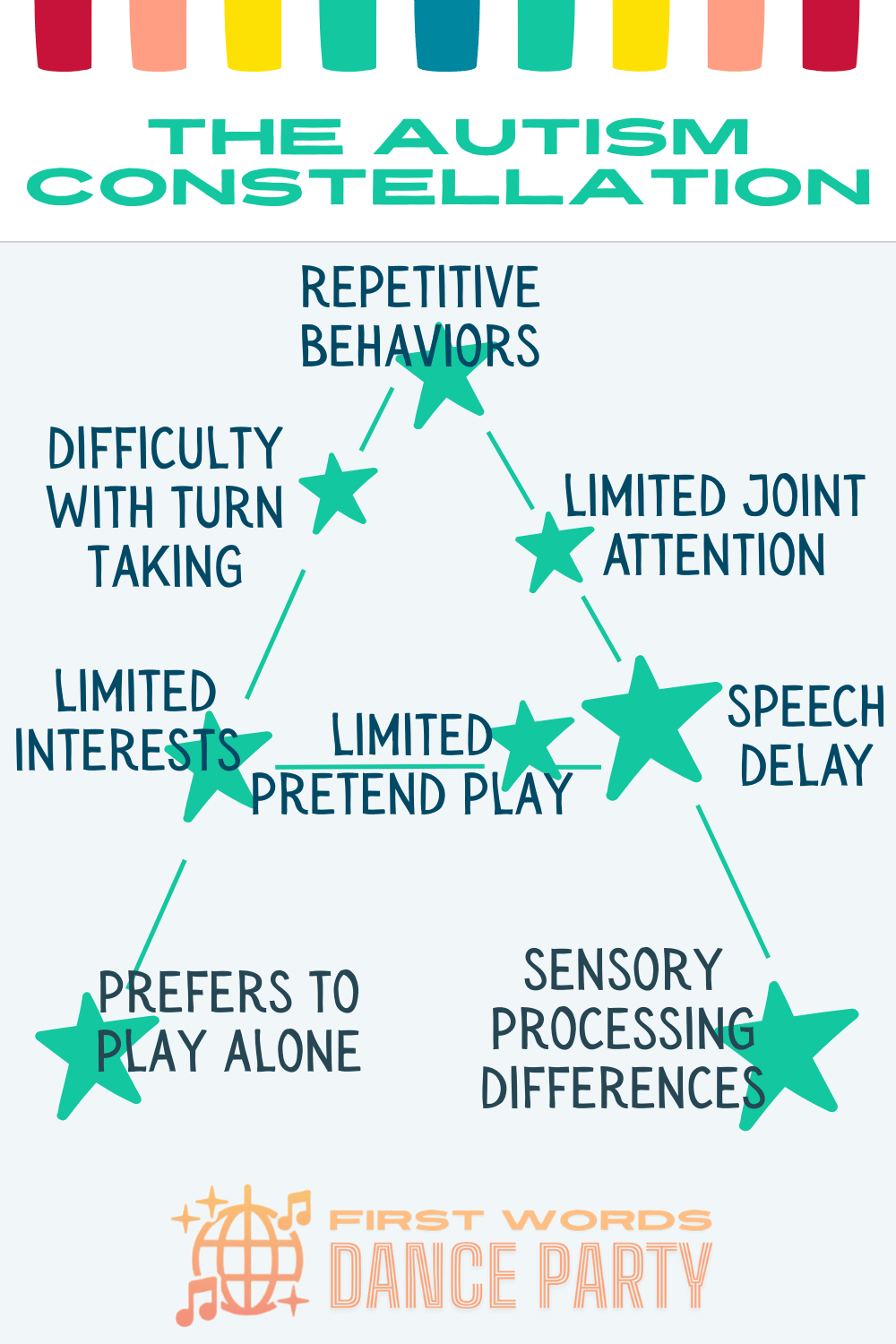
Every child is different
This list is by no means exclusive- these are just the most common characteristics I see every single day when I go from home visit to home visit. Once you have a better understanding of the learning style of autism, the specific examples kind of “click” into place.
Remember that no two children are exactly alike and that autism can also look very different in boys than in girls. Girls tend to appear to be shy or quiet and don’t necessarily do the more “classic” repetitive behaviors, like lining things up- but they may look for order and routine in other ways.
For more information on how autism can present in girls, check out this article from the Child Mind Institute.
What causes autism?
There’s no single known cause of autism, but research suggests it has a strong genetic basis. Brain imaging studies have shown differences in how autistic brains process information and form connections.
According to the CDC, autism is not caused by parenting style, vaccines, or screen exposure—and you didn’t do anything to cause it.
Autism vs speech delay
If you’ve been wondering whether your child’s limited speech is just a delay or something more—you're not alone.
This is one of the most common questions I hear from parents of toddlers. Naturally, you want to know what the road ahead looks like. Let’s break it down.
Autism and speech delay: how to tell the difference
A speech delay means that your child is behind in using words or forming sentences when compared to typical developmental timelines. A speech delay refers to speech and language alone and does not taking into account other areas of development, such as social interaction, play, gross and fine motor, daily living skills like dressing and potty training, and thinking and problem-solving.
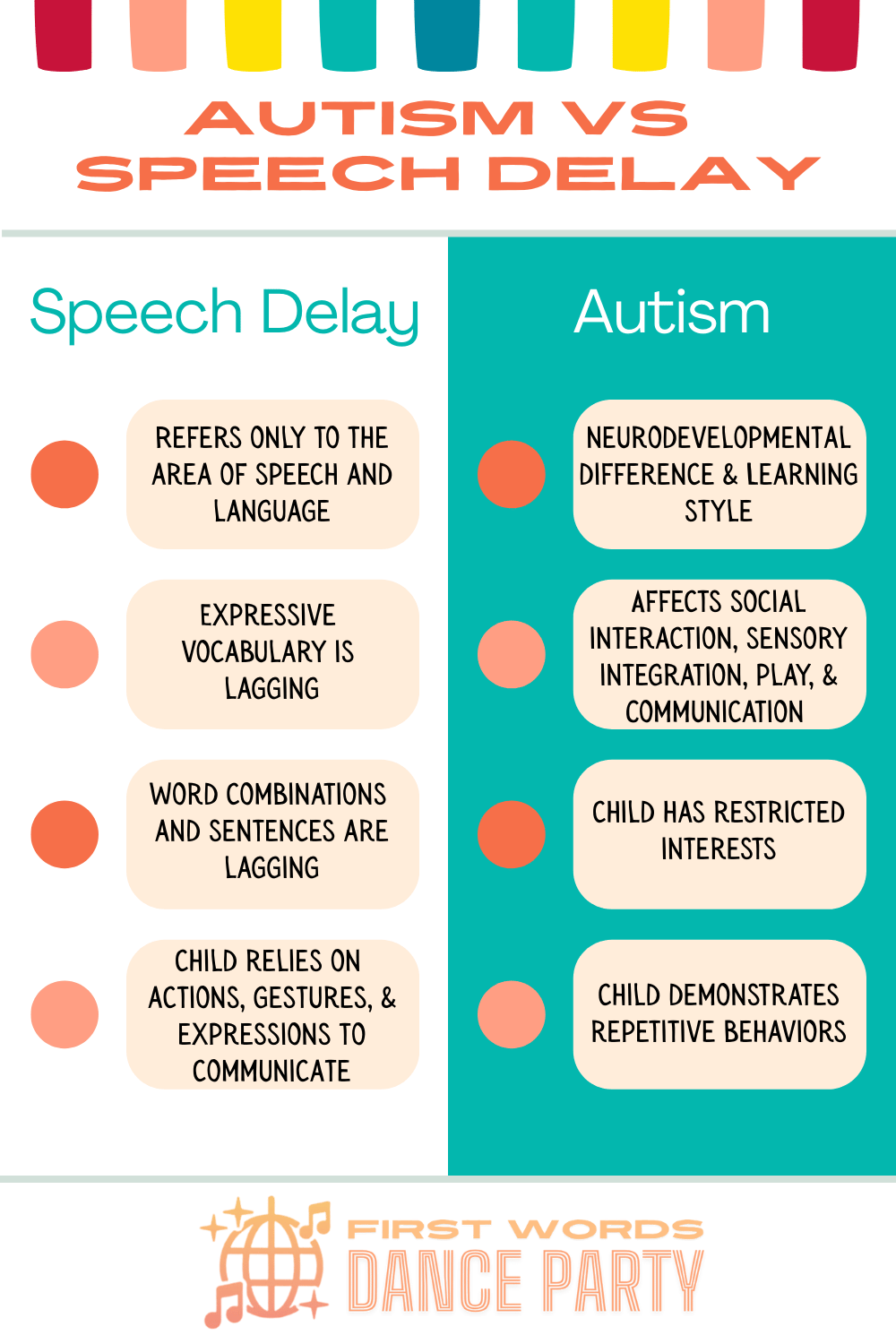
Toddlers and preschoolers with speech delays who demonstrate typical play and social skills generally still:
Communicate with gestures, like pointing, waving, high fives, blowing kisses, and showing you things
Imitate your actions and gestures - even if they can’t imitate your words
Reference your face by looking at you when they had you something or bring you to something they want
Show strong interest in people and would rather play with you than alone
Play with lots of different toys and use lots of different actions with their toys to play (feeding a stuffed animal or baby and putting it to sleep, cooking food by stirring it in a pot and then offering it to you to eat, etc.)
In short, kids with speech delays who otherwise demonstrate typical skills use a combination of foundational skills like gestures, actions, and facial expressions to get their point across. And while they can’t yet imitate a lot of words, they can imitate actions and gestures that you show them with some support, leading to play skills that are on track.

Speech delay and autism: Autism includes differences in more than just speech and language
Autistic children may also experience delayed speech, but it’s part of a broader pattern of developmental differences.
Autistic toddlers may:
Not yet demonstrate joint attention (being socially connected with you and referencing your face to check in with you as they play with or explore an object)
Struggle with imitation—not just of words, but of actions and gestures, too. This often looks like your child randomly saying a word when you don’t expect it, but having a much harder time saying that same word when you prompt them
Have very strong ideas about what to do and how to do it. This can look like crying, walking away, or pushing away when you try to show your toddler a different way to play with a toy, how to explore a different area of the playground, etc.
Prefer to play alone by walking away or pushing you away when you attempt to join them
Thrive with looking at books or photos, saying more words during those activities than during other routines
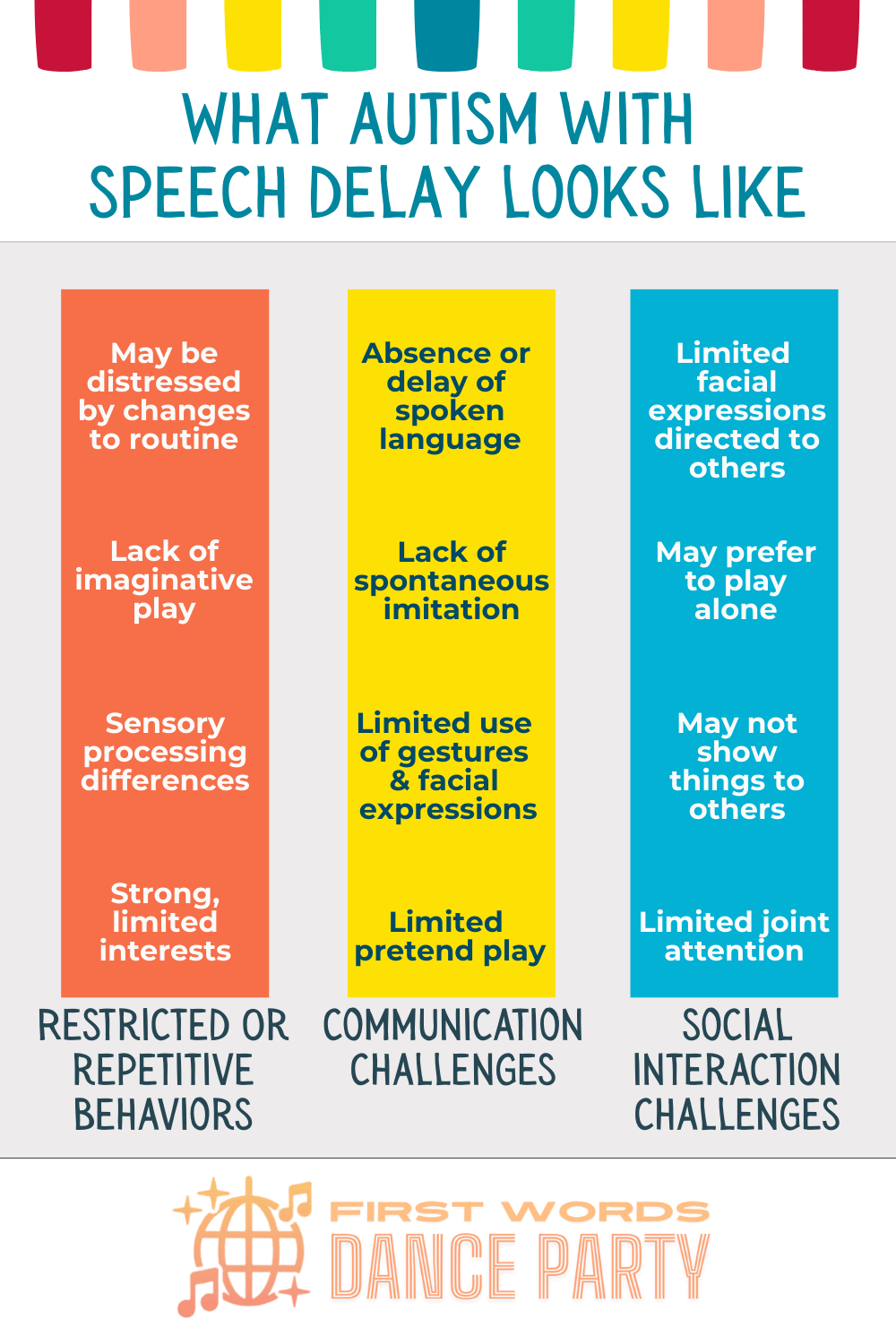
These examples really get to the heart of why speech and language can be challenging for little ones on the autism spectrum. Communication is a two-way street that involves turn taking, lots of nonverbal communication, and imitation.
How do I know if it’s autism or speech delay?
This is a time to trust your intuition and look for the helpers. If several of the examples listed above sound like what you’re seeing with your kiddo, it’s a good idea to seek out an autism evaluation.
Earlier identification is associated with better outcomes, and of course you want the absolute best outcome for your kiddo.
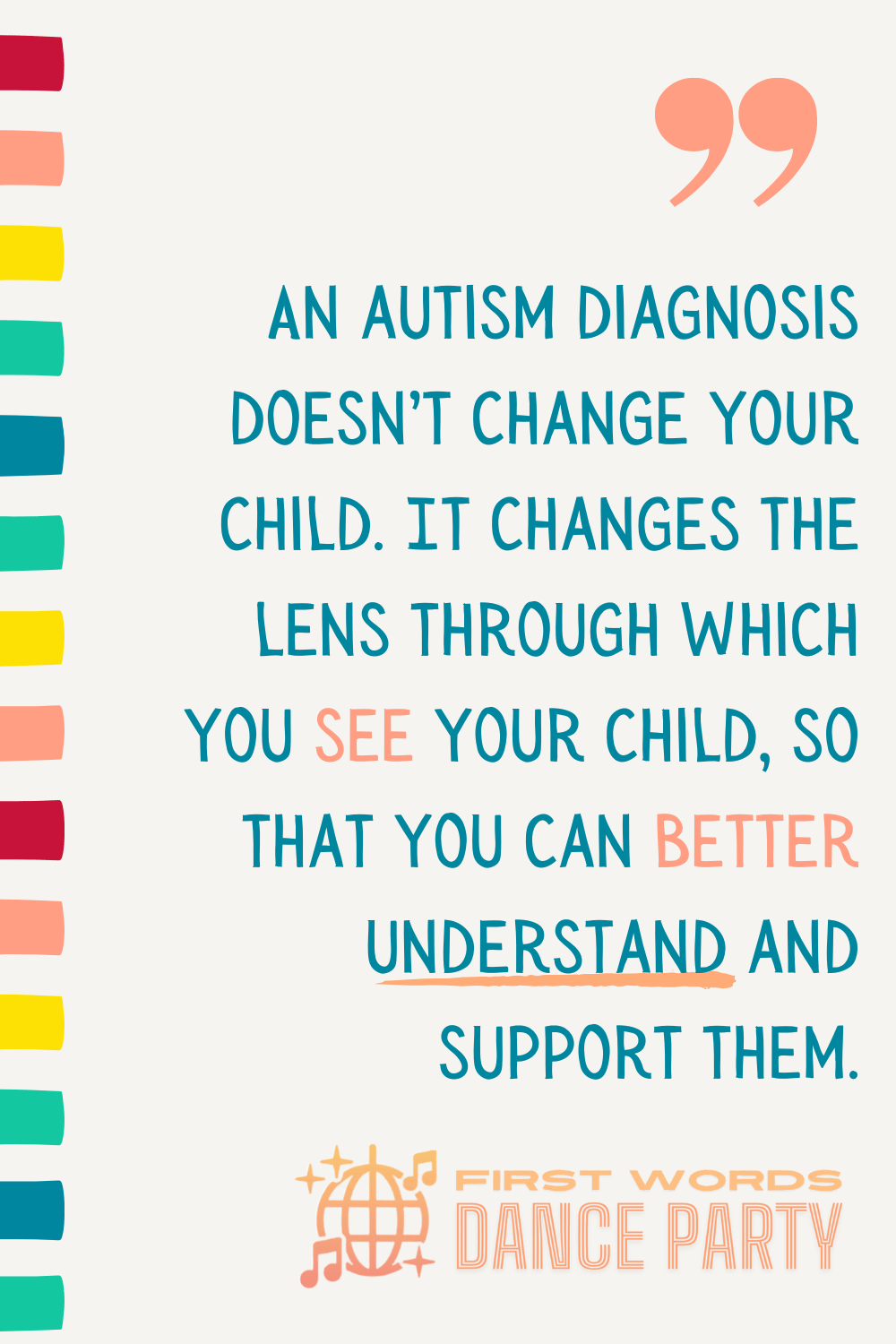
Information is your friend. Is it scary? Absolutely. But your kiddo needs you to advocate for them so that they don’t get missed.
An autism diagnosis doesn’t change your child; it changes the lens through which you see your child, so that you can better understand and support them.
Remember that a child doesn’t have to “check every box” to be autistic, and that it can be hard for your child’s pediatrician to see all of the things that you see on a daily basis. I see this happen a lot when a child smiles or makes eye contact during well child checkups, and then the parent’s questions about autism are dismissed by their pediatrician.
Eye contact and social smiling are just two characteristics that won’t apply to every person on the autism spectrum. It’s more about that “constellation” of characteristics across the three core areas.
Advocating for your child
You may have to really advocate and explicitly ask for a referral to a developmental pediatrician or autism clinic to get answers to your questions. Many have long wait lists, so the sooner you put the wheels in motion, the sooner you’ll get an answer to your question.
Early support is powerful—whether your child has a speech delay, autism, or both.
Music, Connection & Communication for Children with Speech Delays and Autism
If you’ve made it this far, you might be feeling a mix of things—maybe a bit of worry, some “what ifs,” and a deep hope that your child can find their voice.
You’re not alone in that. For many of the parents I coach in early intervention, the hardest part is the waiting, wondering, and worrying.
It’s the daily moments of wondering how to get your child to imitate you and to be more engaged and connected with you. It's the all of the wondering what to do at home to help your child to start talking.
For all of the parents working through these very same struggles, I created First Words Dance Party™- fun, catchy music for speech therapy.
What makes First Words Dance Party’s speech therapy music so dynamic
Every song is built around simple, functional language that’s easy to model and use across daily routines. You’ll hear words and phrases like “shoes on,” “my turn”, “help me” and “open please”.
The lyrics were crafted this way so that these functional phrases can be carried over into real day to day routines.
The lyrics also model the simplest and most accessible syllable shapes. In the world of speech and language, syllable shapes are referred to by the order in which the consonants (C) and vowels (V) are sequenced within them.
Every lyric methodically features these early developing syllable shapes. Consonant-vowel words (CV words like go and me), vowel-consonant words (VC words like up, on), consonant-vowel-consonant words (CVC words like push and pull), and reduplicated patterns (ni-night, bye-bye)—make the lyrics perfect for early verbal imitation.
These songs meet your child exactly where they are, regardless of whether their late talking is due to a speech delay or autism.
Speech therapy songs for a speech delay, autism, and language disorders
These original songs for speech therapy were created not only for children, but for adults, too. They offer a refreshing alternative to traditional nursery rhymes—something you’ll actually enjoy singing along with on repeat. And every lyric uses speech therapy strategies.
Here are a few examples:
The Cookie Song: This kid favorite targets the core words yes and no, along with the words eat, want, what, doggie, and of course, cookie! This one is perfect for kids who aren’t yet gesturing or saying yes and no.
Ready, Set, Go: This one uses a powerful strategy, called an anticipatory set, to promote engagement. It targets the opposite pair stop and go, along with the words push, pull, bubbles, uh-oh, oh no, more, and I.
It’s My Turn: This song is written especially for little ones who don’t have the words yet to ask for a turn to have the item or toy that they want. This is a common struggle for both children with speech delays and children on the autism spectrum, who are learning how to use language to initiate with others. Check on this core word lyrics video to see how easy it is to model simple core words like “my” and “turn” with this music:
You can stream First Words Dance Party on Spotify, YouTube Music, Apple Music, and anywhere else you get your music.
Need some extra support? The Homeschool Speech Therapy Handbook is here to help
If you’ve ever felt the weight of trying to support your child’s speech progress at home—wondering “Where do I even start?” or feeling like the things you have tried just haven’t been successful—you’re absolutely not alone.
Trying to navigate speech therapy home activities that feel meaningful and manageable (rather than another exhausting to‑do) can leave you drained, second‑guessing, and wishing for something simpler.
That’s where the Homeschool Speech Therapy Handbook comes in. Designed specifically for parents (not trained therapists) who want real‑life tools, this guide breaks down exactly what to do, why it works, and how to bring speech‑therapy practice into everyday moments—snack time, bath time, play time—without turning your home into a clinic.
Framed within a song-by-song breakdown of the Speak up and Dance album, you’ll discover how to apply the strategies within each song to real life for easy speech therapy practice at home.
You’ll move from feeling overwhelmed and unsure to feeling confident and connected—watching your child engage, communicate, and grow in ways that feel easy and natural.
Final thoughts
It can be overwhelming when you are wondering if your child’s speech delay could be something more. These questions are big, and they’re real. But here’s the good news:
You don’t need to have all the answers to start supporting your child right now.
Whether your child’s communication struggles are due to a speech delay or autism, music offers a fun and effective way to tap into the language center of the brain. Music helps regulate, engage, and connect. It creates space for shared joy and real communication—without pressure.
If you’re ready to take the first step toward connection and communication with your child, download your free 5 Easy Steps to Kickstart Communication with Music for Speech Therapy at Home.
You don’t need to be a professional singer or a speech therapist to leverage the joy of music for major speech and language success. You just need the right songs, some simple strategies, and the willingness to show up with love and consistency.
I hope this article has guided you with helpful information on your parenting journey. Thanks for reading and for being your child’s biggest advocate.
FAQ: Autism or Speech Delay? Common Questions from Parents
What’s the difference between speech delays and autism?
This is a common question, especially in toddlers. A speech delay means your child is developing speech more slowly than expected but following a typical pattern otherwise. Autism spectrum disorder (ASD), on the other hand, is a broader neurodevelopmental difference that can include communication delays—but also involves differences in social interaction and play, restricted and repetitive interests, and sensory processing.
So when we’re talking about a speech delay vs autism, we’re really asking whether speech is the only aspect of development that has been different than expected, or the communication difference is part of a larger pattern of differences.
Could it be a speech delay, not autism?
Yes, in many cases it can simply be a speech delay, not autism. Some children are late talkers but are otherwise developing social, motor, adaptive, and cognition skills right on track. They may need some extra support to catch up to their same-aged peers.
However, if you're also noticing things like limited engagement with you or limited ability to imitate your actions and gestures, it's worth looking into autism or a broader developmental delay. Trust your gut—and remember, starting early support is never a mistake.
What’s the difference between autism vs developmental delay?
Developmental delay is a general term used when a toddler is behind in one or more areas of development—such as motor, language, or cognitive skills. Autism often includes delays, but it also involves unique patterns of thinking, learning, and interacting with the world.
When comparing autism vs developmental delay, it’s helpful to think of developmental delay as an umbrella term. An child on the autism spectrum may have a developmental delay and vice versa- but the core features of the autism learning style are generally what make it difficult for these little ones to meet their developmental milestones.
What about global developmental delay vs autism?
Global developmental delay (GDD) means delays across multiple domains of development—like communication, cognition, motor, social emotional, and adaptive development—typically identified before age five. Some children with GDD later receive an autism diagnosis, but not always.
Autism includes specific social communication differences, whereas GDD can result from a wide range of underlying conditions.
Can music help my child, whether it’s a speech delay or autism?
Yes! Research shows that music-based interventions support expressive language, attention, memory, and emotional regulation—making them effective for both speech delays and autism (Sharda et al., 2018; Wan et al., 2010). Whether your child has a speech delay or autism, or if they've been diagnosed with a language disorder, music is a joyful way to build communication and connection.
1 comment

To tell if your child's speech delay is a sign of autism or a separate issue, observe their social interaction and nonverbal communication. Know more from https://natautism.com/en/the-most-beneficial-supplements">natautism.com</a>
